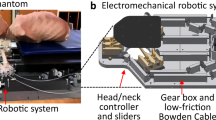Abstract
Immobilization devices may be a valuable aid to ensure the improved effectiveness of radiotherapy treatments where constraining the movements of specific anatomical segments is crucial. This need is also present in other situations, specifically when the superposition of various medical images is required for fine identification and characterization of some pathologies. Because of their structural characteristics, existing head immobilization systems may be claustrophobic and very uncomfortable for patients, during both the modeling and usage stages. Because of this, it is important to minimize all the discomforts related to the mask to alleviate patients’ distress and to simultaneously guarantee and maximize the restraint effectiveness of the mask. In the present work, various head immobilization mask models are proposed based on geometrical information extracted from computerized tomography images and from 3D laser scanning point clouds. These models also consider the corresponding connection to a radiotherapy table, as this connection is easily altered to accommodate various manufacturers’ solutions. A set of materials used in the radiotherapy field is considered to allow the assessment of the stiffness and strength of the masks when submitted to typical loadings.















Similar content being viewed by others
References
J. Ferlay, I. Soerjomataram, M. Ervik, R. Dikshit, S. Eser, C. Mathers, M. Rebelo, D.M. Parkin, D. Forman, F. Bray, GLOBOCAN 2012: estimated cancer incidence, mortality and prevalence worldwide in 2012 v1.0. IARC CancerBase no. 11. ISBN-13 978-92-832-2447-1
National Cancer Institute, A Snapshot of Head and Neck Cancer, Institute, U.S. Department of Health and Human Services, 2013 (27 Jan 2015)
S. Pelengaris, M. Khan (eds.), The Molecular Biology of Cancer (Blackwell and Publishing, Oxford, 2006), pp. 1–30
A. Rahmim, K. Dinelle, J.C. Cheng et al., Accurate event-driven motion compensation in high-resolution PET incorporating scattered and random events. IEEE Trans. Med. Imaging 27(8), 1018–1033 (2008). https://doi.org/10.1109/TMI.2008.917248
M. Wardak, K.P. Wong, W. Shao et al., Movement correction method for human brain PET images: application to quantitative analysis of dynamic 18F-FDDNP scans. J. Nucl. Med. 51(2), 210–218 (2010). https://doi.org/10.2967/jnumed.109.063701
J. Mar, M.S. Monteiro, V.F. Vieira et al., Value of a lower limb immobilization device for SPECT/CT image fusion optimization. J. Nucl. Med. Technol. 43(2), 98–102 (2015). https://doi.org/10.2967/jnmt.114.145771
A. Tessitore, A. Giordano, R. De Micco et al., Sensorimotor connectivity in Parkinson’s disease: the role of functional neuroimaging. Front. Neurol. 5, 180 (2014). https://doi.org/10.3389/fneur.2014.00180
M. Fisher, C. Applegate, M. Ryalat et al., Evaluation of 3-D printed immobilisation shells for head and neck IMRT. Open J. Radiol. 4, 322–328 (2014). https://doi.org/10.4236/ojrad.2014.44042
S. Chen, Y. Lu, C. Hopfgartner et al., 3-D Printing based production of head and neck mask for radiation therapy using CT volume data: a fully automatic framework, in Proceeding-International Symposium on Biomedical Imaging (2016), pp. 403–406. https://doi.org/10.1109/isbi.2016.7493293
E. Sousa, L. Vieira, D. Costa et al., Comparison between 3d laser scanning and computed tomography on the modelling of head surface, in 3rd International Conference on Numerical and Symbolic Computation—SYMCOMP 2017. Guimarães, Portugal. ECCOMAS—European Community on Computational Methods in Applied Sciences (2017), pp. 119–128
M.A.R. Loja, E. Sousa, L. Vieira, D.M.S. Costa, D.S. Craveiro, R. Parafita, D.C. Costa, Using 3D anthropometric data for the modelling of customised head immobilisation masks. Comput. Methods Biomech. Biomed. Eng. Imaging Vis. (2019). https://doi.org/10.1080/21681163.2018.1507840
J. Schindelin, I. Arganda-Carreras, E. Frise et al., Fiji: an open-source platform for biological-image analysis. Nat. Methods 9(7), 676–682 (2012). https://doi.org/10.1038/nmeth.2019
SolidWorks. https://www.solidworks.com/product/solidworks-simulation. Accessed 10 Jan 2018
Material Property Data – MATWEB. 2017. http://www.matweb.com/index.aspx. Accessed 10 Jan 2018
Gamma Compatible Materials. 2011. Nordion: Science Advancing Health. http://www.nordion.com. Accessed 27 Dec 2017
J.N. Reddy, An Introduction to the Finite Element Method, 2nd edn. (McGraw-Hill, New York, 1984)
M.A.R. Loja, J.I. Barbosa, C.M. Mota Soares, Analysis of sandwich beam structures using kriging based higher order models. Compos. Struct. 119, 99–106 (2015). https://doi.org/10.1016/j.compstruct.2014.08.019
S. Almosnino, L. Pelland, J.M. Stevenson, Retest reliability of force-time variables of neck muscles under isometric conditions. J. Athl. Train. 45, 453–458 (2010). https://doi.org/10.4085/1062-6050-45.5.453
Acknowledgements
The authors wish to acknowledge Fundação Champalimaud for the possibility of obtaining the CT images, which were essential to this study.
Author information
Authors and Affiliations
Corresponding author
Additional information
This work was supported by the Project IPL/2016/SoftImob/ISEL and Project LAETA—UID/EMS/50022/2019.
Rights and permissions
About this article
Cite this article
Loja, M.A.R., Craveiro, D.S., Vieira, L. et al. Radiotherapy-customized head immobilization masks: from modeling and analysis to 3D printing. NUCL SCI TECH 30, 142 (2019). https://doi.org/10.1007/s41365-019-0667-2
Received:
Revised:
Accepted:
Published:
DOI: https://doi.org/10.1007/s41365-019-0667-2




